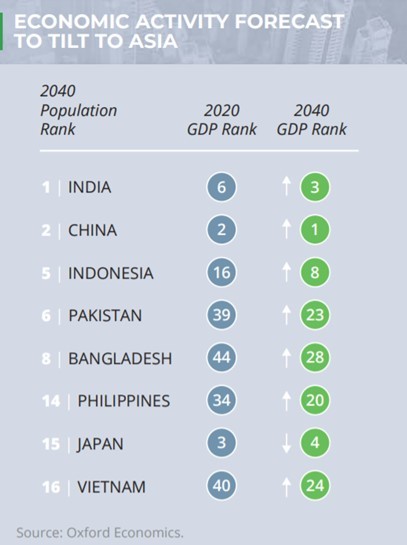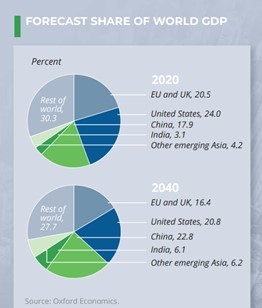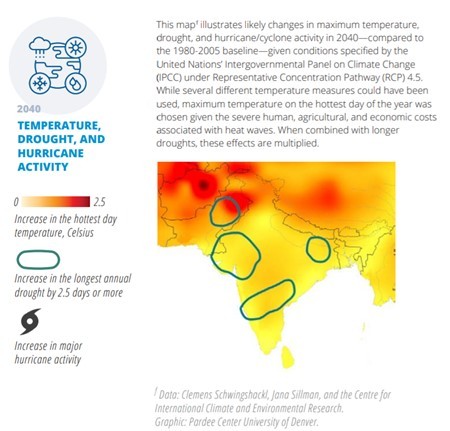According to the recent 7th edition of the “Global Trends” report by the US intelligence agency, Pakistan is on track to become the world’s 23rd largest economy by 2040. Currently, the position according to the GDP is 39th, meaning that the country will move 16 places by the next to decades.

The corporate author, US National Intelligence Council publishes such reports to guide the policymakers and other stakeholders to have certain expectations and make policies accordingly.
The structural factors for such a forecast include economic, environmental, technological, and demographic indicators that impact societies all over the world.
However, the report also, “examines how these structural forces interact and intersect with other factors to affect emerging dynamics at three levels of analysis: individuals and society, states, and the international system.”
Read More: Pakistan ranked among the worst five countries for women, WEF
According to the report, the most certain trends during the next 20 years will be major demographic shifts as global population growth slows and the world rapidly ages. Some developed and emerging economies, including in Europe and East Asia, will grow older faster and face contracting populations, weighing on economic growth.
However, “populous countries that most likely will still be below the median age threshold in 2040 are Afghanistan, Egypt, and Pakistan.”
Karachi is poised to become the 4th largest city in the world by 2035, with a population of 23.1 percent.
“Global economic activity has been tilting toward Asia during the past 40 years, reflecting its higher rate of economic growth in comparison with the rest of the world,” along with poverty alleviation in the region.
The NIC report stated that “ In 2020, China and other developing Asia countries contributed 18 percent and 7 percent respectively to global GDP,” and if the trend continues then by 2040, India and China alone will contribute 29 percent of GDP, while the rest of Asia contributes 6 percent.

According to the report, the growing economy could be pushed by increasing population in these areas, for example, Indonesia, the 4th most populous country, is poised to be among the top 10 economies of the world by 2040.
The report warned us of trade disruptions and lower standards of living in these areas though.
Climate Change
The NIC report said that disease, the rich-poor gap, climate change, and conflicts within and among nations will pose greater challenges in coming decades, with the Covid-19 pandemic already worsening some of those problems.
Regional powers and non-state actors may exert greater influence, with the likely result of “a more conflict-prone and volatile geopolitical environment” and weakened international cooperation, it said.
Mentioning the ongoing tensions between the US and China, the report said, they will intensify, fueled by military power shifts, technology, demographics, and “hardening divisions over governance model.”
The report talks about, “likely changes in maximum temperature, drought, and hurricane/cyclone activity in 2040—compared to the 1980-2005 baseline.”

According to the report central and northern part of Punjab and some of KPK is expected to have the highest increase in temperature over the said period. Moreover, the drought period for the central and southern Punjab and some parts of Balochistan is forecasted to increase by at least 2.5 days.
Read More: Exports increase 8.74pc to Rs2.651 trillion in 8 months: PBS report
The report shows that in Asia, only 25.8 percent of the population uses the internet. On a scale of 1-7, the Digital skills of the workforce are rated at 4.6, and on a scale of 1-100, information globalization rates Asians at 86.3.
Impact of COVID-19
According to the report, the novel coronavirus pandemic that has killed more than three million people marked the greatest “global disruption” since World War Two, with the consequences likely to last for years.
It has widened disparities in areas like healthcare, national debt, increased nationalism, and polarization, deepened inequality in societies, fueled distrust in government, and highlighted the failure of international cooperation.
In agreement with the other reports, the NIC report says that the pandemic has slowed and is possibly reversing the progress in fighting poverty, disease, and gender parity.
The report posed five scenarios for what the world might look like in 2040.
The most optimistic – a “renaissance of democracies” – found that democratic governments would prove “better able to foster scientific research and technological innovation, catalyzing an economic boom,” enabling them to cope with domestic stresses and to stand up to international rivals.
Read More: Pakistan’s economic recovery remains fragile, World Bank
The most pessimistic scenario – “tragedy and mobilization” – posited how Covid-19 and global warming could devastate global food supplies.














